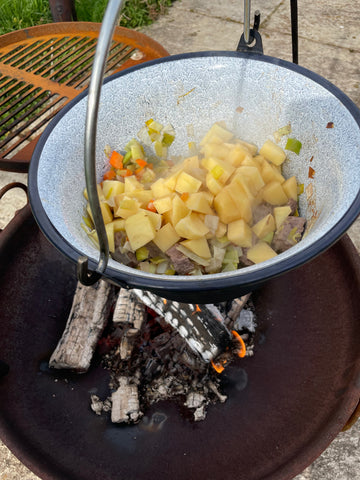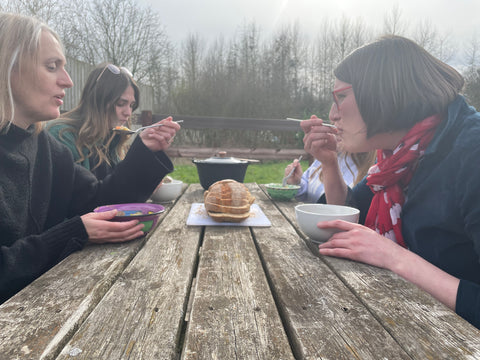Cooking on Wood - Traditional Irish Stew
In light of St Patrick's Day, we thought it was only suitable to make our very own traditional Irish stew!

| Prep: 20 mins | |
| Cook: 2 hrs 20 mins | |
| Servings: 8 servings |
We acquired all of our ingredients from one of our favourite local farm shops, Oakchurch. We love their commitment to support local farmers and due to low food miles, the ingredients are always so fresh and tasty. Whenever possible, support your local producers.



Step 1:
Firstly, set up your firepit. We used our Firepit Celeste to light our fire in and Grill & Chill logs which are thinner cut and so making it easier to control the heat output. You can light your fire in two ways:
1. Using kindling and a Flamer natural firelighter and creating a jenga shape in a top down or traditional logs-on-top method
2. Using our new KindleFlamer where you require no kindling at all and simply place the KindleFlamer between two logs
We used a Hungarian-style kotlich to cook our stew in as pictured below. This is a great appliance which hangs on a adjustable chain from a tripod, making it easy to lift or drop depending on how much heat you want.



Step Two:
Peel, chop and dice your fresh vegetables ready for cooking.



Don't forget to compost your vegetable peelings! Read about our composting tips in this blog!


Step Three:
After preparing your fresh organic produce, pour oil into your kotlich and let it heat up. Add chopped onion into the pot and fry until browned. Mix occasionally to not let the onion burn - depending on the heat of your fire, this could take anything between 4-10 minutes.



Step Four:
Once sizzling, proceed to add the chopped leeks and carrots and let everything cook until softened.



Step Five:
Add the meat and make sure to stir the contents so the meat cooks evenly. We cooked ours for approximately 30 minutes but it will depend on the heat of your fire. The meat should brown all over before moving onto step six.



Step Six:
Once your meat is cooked, it is time to add your potatoes. Mix well and let it fry for a few minutes.


Step Seven:
Add the flour, salt and pepper and mix it all up. Let it fry for a couple of minutes then add the stock. Give it a good mix, cover with a lid and let it cook for half an hour on a good heat, with an occasional mix preventing it from burning on the bottom. Make sure to add more logs when required.



Step Eight:
After half an hour of cooking on good heat, you should have a nice thick stew. Add shredded cabbage leaves, give your stew a stir and pop the lid on. Leave to cook for another 15-20 minutes.

Step Nine:
Carefully lift the lid and give it a stir. Grab a spoon and have a taste of the potatoes. These should be soft and rather than hard. Leave cooking for longer if required until the potatoes have softened nicely and the meat breaks apart easily.

Step Ten:
Once cooked, dish up and serve to friends and family, preferrably still outside in the beautiful Herefordshire countryside. We paired it with some bread we purchased from our Oakchurch. If you want to be more adventurous, you could always try making your own campfire bread too. Get the recipe here.


References
[1] History of Irish Stew- https://thewildgeese.irish/profiles/blogs/the-story-behind-the-traditional-irish-stew - (15/03/22)
